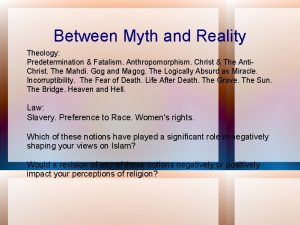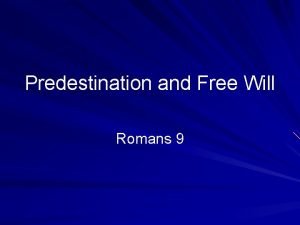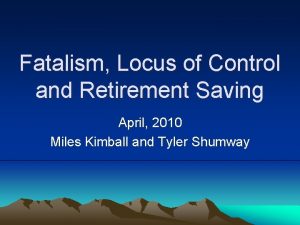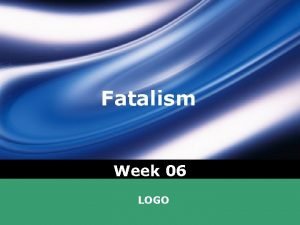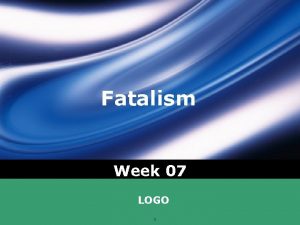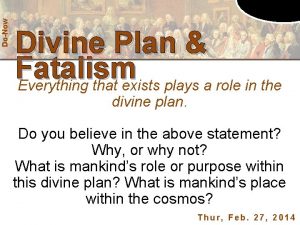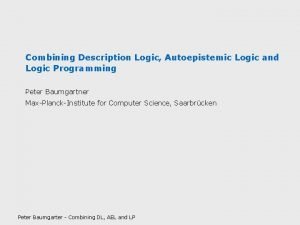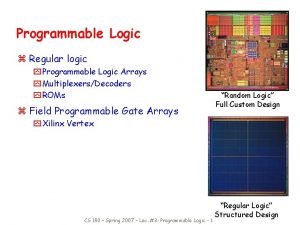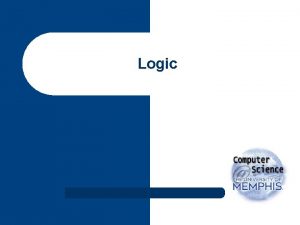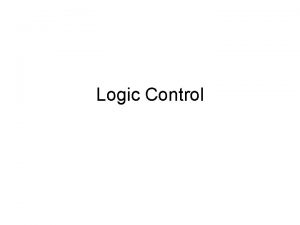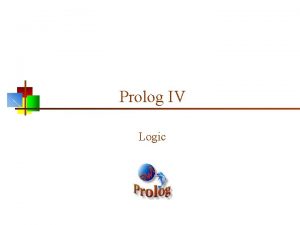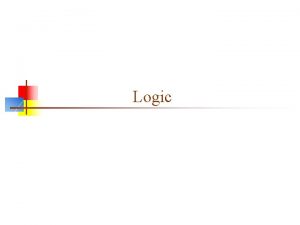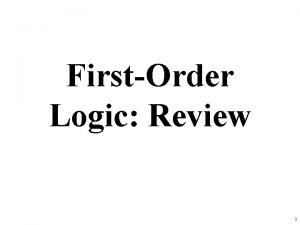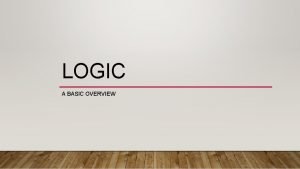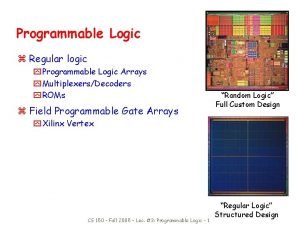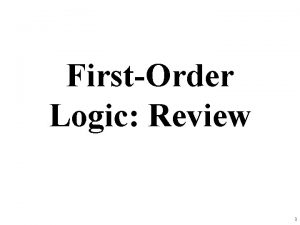LOGIC FATALISM AND FUTURE CONTINGENTS 1 Linear time




























- Slides: 28

LOGIC FATALISM AND FUTURE CONTINGENTS 1

Linear time • We assume that time is linear. 2

Instants • We have three instants: t 1, t 2 and t 3. • The instant t 1 precedes the instant t 2. • The instant t 2 precedes the instant t 3. • The instant t 1 is a past instant. • The instant t 2 is the present instant. • The instant t 3 is a future instant. 3

Presentism • Whatever exists is present. • Whatever exists is in the instant t 2. 4

Events • The event *p 1* is in the instant t 2. • The event *~p 2* is in the instant t 2. 5

Dated sentences about the present • The dated sentence about the present @(t 2, p 1) means ‘the event *p 1* is in the instant t 2’. • The event *p 1* is the truth-maker of the sentence @(t 2, p 1). • The sentence @(t 2, p 1) is true. • The sentence @(t 2, p 2) is false. 6

Abstract ex-concrete objects • The abstract ex-concrete object *~ex-c 1* is in the instant t 2. • The abstract ex-concrete object *ex-c 2* is in the instant t 2. 7

Dated sentences about the past • The dated sentence about the past @(t 2, @(t 1, ~p 1)) means ‘in the instant t 2 it’s true that the event *~p 1* was in the instant t 1’. • The object *~ex-c 1* is the truth-maker of the sentence @(t 2, @(t 1, ~p 1)). • The sentence @(t 2, @(t 1, ~p 1)) is true. • The sentence @(t 2, @(t 1, ~p 2)) is false. 8

Abstract ab-concrete objects • The abstract ab-concrete object *ab-c 1* is in the instant t 2. • The abstract ab-concrete object *ab-c 2* is in the instant t 2. 9

Dated sentences about the future • The dated sentence about the future @(t 2, @(t 3, p 1)) means ‘in the instant t 2 it’s true that the event *p 1* will be in the instant t 3’. • The object *ab-c 1* is the truth-maker of the sentence @(t 2, @(t 3, p 1)). • The sentence @(t 2, @(t 3, p 1)) is true. • The sentence @(t 2, @(t 3, ~p 2)) is false. 10

Time-units • We have two time-units: x 1 and x 2. • The two time-units x 1 and x 2 are whole quantities. • The time-units x 1 is the time interval between the instant t 1 and the instant t 2. • The time-units x 2 is the time interval between the instant t 2 and the instant t 3. 11

Metric sentences about the past • The metric sentence about the past P(x 1)~p 1 means ‘x 1 time-units ago there was the event *~p 1*’. • The sentence P(x 1)~p 1 is equivalent to the sentence @(t 2, @(t 1, ~p 1)). • The object *~ex-c 1* is the truthmaker of the sentence P(x 1)~p 1. • The sentence P(x 1)~p 1 is true. • The sentence P(x 1)~p 2 is false. 12

Metric sentences about the future • The metric sentence about the future F(x 2)p 1 means ‘in x 2 time-units there will be the event *p 1*’. • The sentence F(x 2)p 1 is equivalent to the sentence @(t 2, @(t 3, p 1)). • The object *ab-c 1* is the truthmaker of the sentence F(x 2)p 1. • The sentence F(x 2)p 1 is true. • The sentence F(x 2)~p 2 is false. 13

The DCL-argument • The DCL-argument is Diodorus Cronus and Lavenham’s argument. • This argument has five premises but the most important ones are (P 3) and (P 5): • [(P 1) F(x 2)p→P(x 1)F(x 2)p]; • [(P 2) □(P(x 2)F(x 2)p→p)]; • (P 3) P(x 2)p→□P(x 2)p; • [(P 4) (□(p→q)&□p)→□q]; • (P 5) F(x 2)p˅F(x 2)~p. 14

(P 3) The necessity of the past • (P 3) P(x 2)p→□P(x 2)p. • This symbol ‘□’ means ‘it is necessary that. . . ’. • The premise (P 3) means ‘If x 2 time-units ago there was the event *p*, then it is necessary that x 2 time-units ago there was the event *p*. • The premise (P 3) expresses the necessity of the past. • For each true sentence about the past, in the present there is the abstract ex-concrete object as the truth-maker of the sentence. • In other words, each true sentence about the past matches an abstract exconcrete object, as truth-maker of the sentence, in the present. • Every true sentence about the past is necessarily true. 15

(P 5) (PFME)The principle of the future middle -excluded • (P 5) F(x 2)p˅F(x 2)~p. • The premise (P 5) means ‘in x 2 time-units there will be the event *p* or in x 2 time-units there will be the event *~p*. • The premise (P 5) expresses the principle of the future middleexcluded (PFME). • In the future there will be an event or in the future there will be the opposite of that event. 16

(LF) Logic fatalism • From the five premises (P 1)-(P 5), it is possible to infer the conclusion: • (LF) □F(x 2)p˅□F(x 2)~p. • The conclusion (LF) means ‘it is necessary that in x 2 time-units there will be the event *p* or it is necessary that in x 2 time-units there will be the event *~p*. • The conclusion (LF) expresses logic fatalism, the necessity of the future. This is equivalent to close future or determinism. Therefore, there is not freedom. • For each true sentence about the future, in the present there is the abstract abconcrete object as truth-maker of the sentence. • In other words, each true sentence about the future matches an abstract abconcrete object, as truth-maker of the sentence, in the present. • Every true sentence about the future is necessarily true. 17

The LF-ontology • The DCL-argument assumes an ontology in which for every couple of abstract ab-concrete objects - one denying the other -, one of them is in the present. We call this ontology ‘LF-ontology’ by ‘logic fatalism’. • For the couple of objects *ab-c 1* and *~ab-c 1*, the object *ab-c 1* is in the instant t 2. 18

The LF-ontology (2) • The LF-ontology implies the conclusion (LF). • In order to deny the conclusion (LF), it is necessary to deny at least one premise of the DCL-argument. • But in order to deny at least one premise of the DCL-argument, it is necessary to assume an ontology different from the LF-ontology. • The Peirce-system denies the premise (P 5). • The Ockham-system denies the premise (P 3). • We won’t treat Ockham-system. 19

The FC-ontology • We assume an ontology in which for not every couple of abstract abconcrete objects - one denying the other -, one of them is in the present. We call this ontology ‘FC -ontology’ by ‘future contingents’. • For the couple of objects *ab-c 1* and *~ab-c 1*, none of them is in the instant t 2. 20

Future contingents • The topic of future contingents is the problem of attributing a truthvalue to every sentence about the future that does not have the truth -maker in the present. • Is the sentence F(x 2)p 1 true or false? • Is the sentence F(x 2)~p 1 true or false? 21

The Peirce-system • In the Peirce-system every sentence about the future, which does not have the truth-maker in the present, is false. • In the Peirce-system: • the sentence F(x 2)p 1 is false; • the sentence F(x 2)~p 1 is false; • hence, F(x 2)p 1˅F(x 2)~p 1 is false; • hence, the premise (P 5) (PFME) [F(x 2)p˅F(x 2)~p] is false. • The DCL-argument isn’t valid in the Peirce-system with the FC-ontology. 22

(PME) The principle of the middle-excluded • In the Peirce-system: • the sentence F(x 2)p 1 is false; • the sentence ~F(x 2)p 1 is true because it is the negation of F(x 2)p 1, that is false; • hence, F(x 2)p 1˅~F(x 2)p 1 is true. • (PME) p˅~p • (PME’) F(x 2)p˅~F(x 2)p • Denying the premise (P 5) (PFME) [F(x 2)p˅F(x 2)~p], the Peirce-system does not deny the principle (PME). • The sentence F(x 2)~p in not equivalent to the sentence ~F(x 2)p. • The sentence F(x 2)~p is not the negation of the sentence F(x 2)p. 23

Conclusion (1) • If we assume the LF-ontology, then the DCL-argument is valid. • If we assume the FC-ontology, then the DCL-argument is not valid. • The Peirce-system assumes the FC-ontology and it denies the principle (PFME). This denial makes the DCL-argument not valid in the Peirce-system as we wanted to prove. 24

Conclusion (2) • The LF-ontology implies logic fatalism or close future or determinism. • Every future event, including volitions, is pre-determined by a cause in a previous instant. • The FC-ontology implies open future or indeterminism. • Not every future event is pre-determined by a cause in a previous instant. Indeed, not for every couple of abstract ab-concrete objects one denying the other -, one of them is in the present. I. e. , our future volition and its opposite are abstract ab-concrete objects that are not yet in the present. Hence, our volition is not pre-determined in a previous instant until we decide it (see Prior, Some Free Thinking about Time). 25

Conclusion (3) • We cannot say anything nor can we prove anything without assuming any ontology in a previous instant. • Do not think that there is the FC-ontology because there is the valid DCL-argument. It is exactly the opposite. There is the DCL-argument because there is the FC-ontology. If we assume the FC-ontology, then there is the valid DCL-argument. • We can choose which ontology to assume. 26

Conclusion (4) • When someone tells us that we are not free, he usually tries to demonstrate this by saying that our will is always pre-determined (consciously or unconsciously) by a previous cause. To be true, he is not proving anything, but he is assuming the FC-ontology. Nevertheless, as an assumption, it cannot be demonstrated. Otherwise, we would have a petitio principii. Indeed, we cannot prove experimentally that all our volitions are pre-determined. • I think that we might be free by assuming the FC-ontology. On the contrary, by assuming the LF-ontology, we might not. 27

Bibliography • Øhrstrøm, Peter and Hasle, Per, "Future Contingents", The Stanford Encyclopedia of Philosophy (Winter 2015 Edition), Edward N. Zalta (ed. ), URL = <https: //plato. stanford. edu/archives/win 2015/entries/futurecontingents/>, pp. 1 -28. • Orilia F. , On the Existential side of the Eternalism-Presentism Dispute, Manuscrito – Rev. Int. Fil. Campinas, v. 39, n. 4, pp. 225 - 254, out. -dez. 2016, URL = <https: //periodicos. sbu. unicamp. br/ojs/index. php/manuscrito/article /view/8647885/14669>, pp. 238 -250. 28
 Future continuous and future perfect continuous difference
Future continuous and future perfect continuous difference Future perfect e future continuous
Future perfect e future continuous First order logic vs propositional logic
First order logic vs propositional logic First order logic vs propositional logic
First order logic vs propositional logic First order logic vs propositional logic
First order logic vs propositional logic Concurrent vs sequential
Concurrent vs sequential Cryptarithmetic problem logic+logic=prolog
Cryptarithmetic problem logic+logic=prolog Software development plan
Software development plan Combinational logic sequential logic
Combinational logic sequential logic Combinational logic sequential logic 차이
Combinational logic sequential logic 차이 Logic chapter 3
Logic chapter 3 Example of elapsed time
Example of elapsed time Future continuous.
Future continuous. Past continuous diagram
Past continuous diagram Future plans and finished future actions
Future plans and finished future actions Future continuous
Future continuous Kondicional 1 engleski
Kondicional 1 engleski Simple linear regression and multiple linear regression
Simple linear regression and multiple linear regression Linear texts
Linear texts Non linear plot meaning
Non linear plot meaning Non linear pipeline processor
Non linear pipeline processor Linear and nonlinear
Linear and nonlinear Linear impulse and momentum
Linear impulse and momentum Quadratic simultaneous equations
Quadratic simultaneous equations Linear grammar
Linear grammar Difference between linear and nonlinear equations
Difference between linear and nonlinear equations How to solve non linear simultaneous equations
How to solve non linear simultaneous equations Future perfect interrogative
Future perfect interrogative Facts about tenses
Facts about tenses































